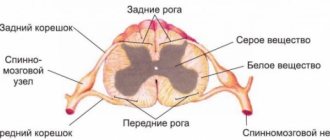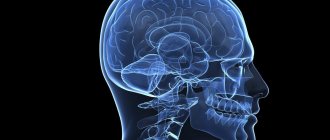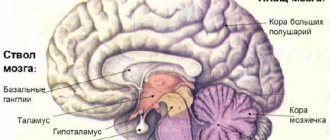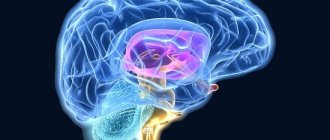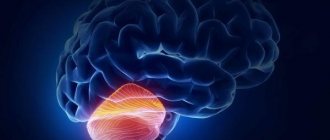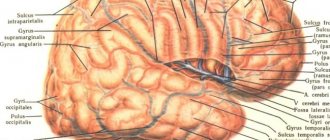What is it and what does it consist of
The human brain consists of two types of nervous tissue - gray matter and white matter. The gray matter of the nervous system is a collection of nerve cells responsible for most of the functions of higher nervous activity in humans. The function of white cells is to transmit electrical impulses to different parts of the brain. The thickness of gray brain tissue reaches about half a centimeter in the population. Topographically, the gray matter is the membrane of the brain, under it there is a cluster of long processes (axons), that is, the matter is white.
The gray matter is formed by an accumulation of soma neurons, small capillaries, glial tissue and short processes - dendrites. In addition, the gray matter includes long unmyelinated processes - axons. Unlike gray matter, which does not have myelin fibers, white matter is called white because its color is given by the sheaths of axons consisting of myelin.
Gray matter nuclei are histological structures, concentric clusters of nerve cell bodies that perform a specific function in the nervous system. Anatomically, two subtypes of nuclei are distinguished: nuclei in the central nervous system and those in the structure of the peripheral nervous system. Each nucleus is a regulator of a specific body function, be it the act of urination or the center of the heartbeat.
There is a partially erroneous belief that gray matter consists of long processes of neurons. Specialized processes, equipped with a fast conductor myelin, are found in the structure of the white matter of the brain and spinal cord, while in the gray substance there are only dendrites and long unmyelinated fibers. The bottom line is that myelinated long axons are not needed in the cortex, because the gray matter of the brain consists of clusters of adjacent neuron bodies, and information from cells to cells is transmitted by short processes (dendro-dendritic synapses), because the main task of long processes is the transmission of electrical impulses from one center to another. There, the function of transmitting and receiving information is served by axo-axonal or axo-dendritic synapses. Gray matter is the same in all parts of the brain. It is the same in different departments. Therefore, the gray matter of the telencephalon includes that set of elements that are also inherent in other brain structures.
Where is it located in the brain
The question of where the gray matter of the brain is located is answered by several basic theoretical medical sciences - normal and topographic anatomy and histology. Other brain sciences study its function rather than its location and structure. Gray matter is the cerebral cortex. On average, the layer of dark fabric is about 3-4mm (from 1.5 to 5mm). It has the most pronounced thickness in the region of the anterior central gyrus. Due to the arrangement of many convolutions and fissures, the area of gray matter increases significantly. In addition to the brain, a layer of gray matter is located inside the spinal cord.
In the cerebellum, the bulk of the gray matter is located by analogy with the brain: the gray matter is the cerebellar cortex and is located on the surface of the structure itself, being its shell, when the white matter is located inside the cerebellum. In addition, the cortex, the coordinating center of the human body, consists of three layers - the molecular ball, piriform neurons and the granular layer.
The cerebral bulb, like other parts of the brain, also has gray substance. The medulla oblongata is one of the first evolutionarily formed brain structures. This part is located at the level of the foramen magnum and passes into the spinal cord. The gray matter of the medulla oblongata forms some nuclei and nerve centers, among which are the nuclei of the cranial nerves and the reticular formation. The nuclei formed by the dark tissue include the hypoglossal, accessory, vagus and glossopharyngeal nerves. It should be noted that all these centers are neither lower nor higher centers of regulation - they occupy an intermediate position in the hierarchy of regulatory systems of the brain.
The structure located above the oblong is called the pons. At its junction with the adjacent structure, several nerves emerge, including the vestibulocochlear nerve. The gray matter of the pons forms its own centers of a mixed nature: the nucleus of the trigeminal nerve, the facial and abducens nerves. Such nerves are responsible for the innervation of the facial (facial) muscles, the scalp (its scalp), some eye muscles and certain parts of the tongue. In addition to such functions, the task of the pons is to maintain the correct posture and partially preserve the location of the body in space. The gray matter of the midbrain is represented by red nuclei and substantia nigra. These structures are collectors of conscious and unconscious movements: the nuclei have rich connections with the cerebellum. In general, these structures are part of the striopadlidal system of the brain.
The cortex, consisting of gray matter, covers many brain structures, including:
- brain;
- cerebellum;
- thalamus;
- hypothalamus;
- subthalamus;
- pale globe;
- basal ganglia;
- shell;
- brain stem structures (red nucleus and substantia nigra);
- cranial nerves.
The conclusion suggests itself that any structure that has a specific regulatory function is covered with an accumulation of gray substance.
General plan of the structure of the human brain
Definition 1
The brain (Latin “cerebrum”, ancient Greek “encephalon”) is the main organ of the human central nervous system, which is a complex multi-level system, which is the highest component of autonomic control and ensures the functioning of all internal organs and the regulation of all life support processes , including higher nervous activity.
The structure of the brain consists of several sections, each of which provides certain functions of the body:
- telencephalon - two hemispheres of the cerebrum, which are connected to each other through the corpus callosum (corpus collosum), and the lateral ventricles;
- diencephalon (it consists of the thalamic region, hypothalamus and third ventricle);
- midbrain (consists of the plate of the quadrigeminal roof, aqueduct and cerebral peduncles);
- hindbrain (pons, cerebellum and part of the fourth ventricle);
- the medulla oblongata, located on the border with the spinal cord, and the second part of the fourth ventricle.
Are you an expert in this subject area? We invite you to become the author of the Directory Working Conditions
The structures of the brain are represented by two types of medulla:
- white matter;
- Gray matter.
In each part of the brain there are structures consisting of white and gray matter, the functions of which differ.
What role does gray matter play?
Millions of years of evolution, natural selection and the origin of species have given the human being a unique structure - a relatively thick cerebral cortex. It is known that the structure of gray matter is properly developed only in representatives of the human species. Unlike lower and even higher mammals, the gray substance has endowed a person with the opportunity to have a unique property of matter, the object of study of all neurosciences and philosophy - consciousness and self-awareness, the resulting abstract thinking, developed memory, inner speech and many other specific attributes of higher nervous activity a reasonable person.
It must be remembered that gray matter is a collection of nerve cells, namely neurons. When talking about the function of gray matter, we are talking about the function of all clusters of neurons with short processes. So, the functions of gray matter are diverse:
- Physiological tasks: generation, transmission, reception and processing of electrical signals.
- Neurophysiological: perception, speech, thinking, memory, vision, emotions, attention.
- Psychological: personality formation, worldview, motivation, will.
For a long time, scientists have wondered what the gray matter of the brain is responsible for. Back in the 18th century, Franz Gall drew attention to the dark brain substance. For the first time, the scientist managed to localize some mental functions on the cortex. Subsequent studies were carried out by removing a section of the cortex and observing which brain function was lost. A serious impetus for further research was the study of the work of the cortex by Academician Pavlov, who studied basic reflexes and the principles of strengthening the conditioned reflex. In parallel, his French colleagues found a speech center in the cortex - the lower part of the frontal gyrus. Modern science, although it knows many properties of the cerebral cortex, claims that the percentage of knowledge on it is no more than one thousandth.
One blind spot in the empirical knowledge of the brain and its formation is the question of what heterotopia of the gray matter of the brain is. In particular, this question is often raised in the field of clinical medicine, where treatment is only symptomatic, that is, the symptoms are removed alone. As is known, heterotopia is a defective accumulation of neurons that have stopped in a certain place and have not reached their histological place. So, if the cause of the pathology is found, there will be an etiological treatment. A variant of the manifestation of heterotopia is childhood epilepsy.
Structure of gray matter
Substantia grisea is an ideal structure consisting of:
- neurons;
- dendrites;
- unmyelinated axons;
- glial cells;
- thin capillaries.
The latter color the bark brown and, contrary to popular belief, the substance is not gray, but grey-brown.
Numerous labyrinth-like depressions and bulges form convolutions known as cerebral gyri. The main function of gray matter is to ensure communication between the human body and the outside world, as well as to regulate reflexes and ensure higher mental functions. And if the substantia grisea consists of neurons, then the substantia alba appears in the form of myelin-covered axons (neuron processes), which act as conductors and serve to transmit signals and provide communication between the hemispheres and nerve centers. The myelin sheath gives the substance its characteristic white color.
The gray substance in the spinal structure resembles the contours of the letter H or the wings of a butterfly. Depending on their location and functions, gray pillars are divided into: rear, front and side. The lateral parts of the dorsal region, in turn, are divided into:
- Posterior - consist of intermediate nerve cells. Receive signals from ganglia.
- The anterior ones consist of motor neurons. The main function is to ensure muscle tone.
- Lateral - consist of sensory and visceral neurons. Responsible for motor functions.
Difference from white matter
This section is intended to calibrate concepts and answer the question of what gray and white matter of the brain are.
Gray matter
- Created by the nuclei of nerve cells and its relatives.
- It is located mainly in the central parts of the nervous system.
- Makes up no more than 40% of the total mass of the brain.
- Consumes about 3-5 ml of oxygen per minute.
- A structure that has a regulatory function.
White matter
- Formed by long myelinated axons.
- It is located primarily in the peripheral nervous system.
- Makes up more than 60% of the weight of the human brain.
- Consumes less than 1 ml of oxygen per minute.
- Responsible for conducting nerve impulses through the nervous system
It should be remembered that unlike the structure of the cerebral cortex, where the gray matter is a shell and covers the white substance, in the spinal cord the gray matter is surrounded by the white matter of the brain.
Functions of gray matter
The work of the central nervous system provides a large number of connections in the body that perform two main functions: control of muscle activity (motor reflex) and provision of sensory perception (sensory reflexes) and higher mental functions: memory, speech, emotions.
The functions of the substantia grisea are determined by its location, for example:
- In the cerebral cortex, the substance is responsible for connecting the body with the outside world, and also carries information and regulates the activity of internal organs, is responsible for ensuring higher nervous activity, thanks to which a person is able to think, remember, perceive, etc.
- In the medulla oblongata, the nuclei of the substance regulate motor processes, balance, ensure coordination of movements, and also regulate metabolism, respiratory processes and blood supply.
- In the cerebellar cortex, the gray nuclei are responsible for coordination of movements and orientation in space.
- In the diencephalon, the nuclei are responsible for controlling the activity of internal organs, regulating reflexes and body temperature.
- In the telencephalon, the nuclei provide motor, reflex control and regulation of higher mental functions: coherent speech, vision, smell, taste, hearing, touch.
The spinal cord is a complex structure that has the following functions: reflex, motor, sensory and conductive. The first three functions are assigned to the gray matter, and the third - to the white matter.
- Reflex function - regulation of unconditioned reflexes: sucking reflex, knee reflex, instant reaction to painful stimuli, etc.
- Motor function – control of muscle reflexes associated with the motor system. The corresponding cells of the spinal cord send signals to a specific group of muscles, prompting one or another action, thanks to which we can purposefully turn our head, move our neck, raise and lower our arms, and walk.
- Sensory function is the transmission of an impulse coming from the afferent fibers of the torso to the parts of the brain, from where the command comes, containing a reaction to the stimulus.
- The conductor function is to ensure the passage of an impulse to the brain, and from there, the passage of an action command going to the corresponding organ. Regulated by the white substance.
The gray substance ensures the normal functioning of a person, his interaction with the outside world, types of human activity, is the basis of cognitive and sensory perception, as well as the basis of motor, reflex, regulatory and all mental functions.
